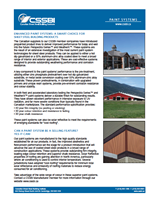 |
| Port Colborne Recreational Centre by Steelway Building Systems |
One of the frequently asked questions when considering a Steel Building System is, "How can storm water be managed effectively?" Traditional flat roofing systems use the roof area to hold the storm water and gradually allow it to drain into the existing storm sewers. However, this practice is coming under increasing scrutiny for several structural, environmental & maintenance reasons including the increasing risk of roof leaks, particularly as the membrane ages. Described in this Fact Sheet are ways that Steel Building Systems can cost effectively manage storm water runoff.
Natural hydrologic balances are often adversely affected by land development. The most significant change is an increase in storm water runoff caused by adding impervious surfaces such as roofs, streets and parking areas. High runoff volumes and greater peak flow rates following property development can result in millions of dollars in damage causing:
- Overloads on existing storm sewers
- Overloads on existing sewage treatment plants
- Lower groundwater tables
- Soil erosion
- Increased pollution of streams and lakes
- Excessive siltation of streams and lakes.
To minimize these affects, an analysis of the capabilities of existing downstream storm water facilities is an essential part of pre-development planning.
What is Storm Water Management
Stormwater management is the practice of controlling storm runoff from urban areas to reduce the impacts of development on the downstream environment. Generally, runoff quantity is controlled, but water quality improvements may also be a design consideration.
Quantity control, which mitigates flooding and erosion, consists of:
- peak flow control
- restriction or optimization of downstream flow rates
- temperature regulation
Quality control, which mitigates environmental impacts, reduces:
- suspended solids, trash and grit
- floatable oils and chemicals
- heavy metals
- nitrogen and phosphates
Deep sandy soils will naturally filter impurities from storm water as it infiltrates to recharge ground water. In areas of shallow soil or fragmented rock, storm water may enter the groundwater quickly making infiltration controls necessary to prevent contamination.
Stormwater Management Solutions
A) Rooftop
Retaining water on the roof is a common approach to manage storm water. This method utilizes the flat roof area, in conjunction with controlled flow drains, to slow down the discharge of the storm water into the storm sewer.
Costs:
- Minimal
Benefits:
- Long draw-down rate vs. low flow rate
- Single piped outlet
- Limited contamination allowing bypass of quality management devices
Drawbacks:
- Water temperature increase may impact downstream fisheries
- Flexing or deterioration of roof membrane
- Higher maintenance
- Higher insurance risk
- Shorter life span
- Structural considerations (i.e. water ponding and ice buildup)
- Potential leaks due to hydraulic pressure
- Standing water infestation
B) Pavement (Car Park Area)
Rainwater, including water from the roof, may be retained on the paved areas. Discharge of water from the catch basins is controlled by outlet devices that restrict flow.
Costs:
- Minimal
Benefits:
- Most expense is in the design/approval stage
- Grading can be used to direct the runoff flow and keep water on the property
- Piped storm systems control and direct discharge to the downstream drainage system
Drawbacks:
- Possibility of short-term pedestrian inconvenience
- Increased maintenance, particularly during winter
- Limited depths allowed in parking lots
- No staged discharge
- Awkward parking grades may be required
C) Landscaped Pond
If the site permits, a pond may be incorporated to retain water and allow it to gradually enter the drainage system, infiltrate or evaporate.
Costs:
- High
Benefits:
- Environmentally desirable
- May incorporate quality controls
- Can be made aesthetically pleasing (at a cost)
Drawbacks:
- Requires landscaped space
- Requires vertical difference for inlet/outlet
- Requires routine maintenance
- Safety risk and health risk associated with standing water
D) Underground Detention/Retention Systems
When control is needed, subsurface detention systems fabricated from corrugated steel pipe (CSP) have proven to be an effective means of attenuating runoff peaks.
These detention systems work as an integral part of the storm sewer system and provide a temporary storage area for excess storm water. Underground detention units begin storing runoff water when inflow exceeds the permissible discharge rate, The detention system accumulates water and discharges it over an extended time period.
CSP underground detention systems can be sized and shaped to meet most site-specific storage needs. Lightweight sections can be assembled quickly to reduce installation costs and shorten site development time. Versatility in sizing, shapes and fittings allow the designer to detail almost any configuration conceivable. Manholes, sumps, elbows, and tees are factory made, simplifying field installation.
The durability of CSP detention systems need not be a concern. Storm runoff is generally not aggressive to metallic coated steel and granular backfill forms a mild environment. When more corrosive effluents are anticipated, alternate coatings, and heavier walled pipe are options that can be used to meet almost any service life requirement.
Costs:
- Moderate (may be recoverable from little to no roof maintenance)
- Design
Benefits:
- Convenient location - underground
- Less inconvenience to pedestrians
- Staged discharge possible
- Manages volume to improve functionality of water quality management system
- May be designed for ground water recharge
- May be designed for retention and supplemental water uses






